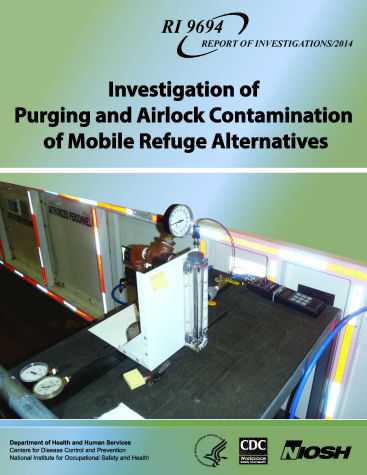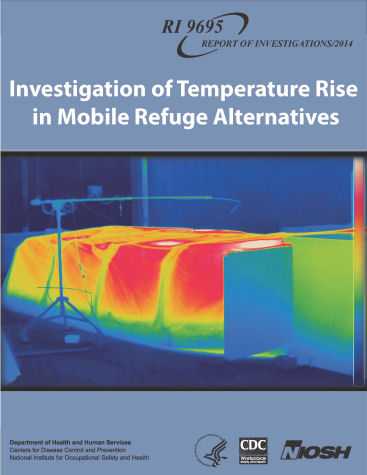Mining Feature: Announcing Two New Sister Publications on Refuge Alternatives
Thursday, March 27, 2014
The NIOSH Office of Mine Safety and Health Research has just published two new Report of Investigations (RIs) on refuge alternatives used in underground coal mines. The research that drove these two reports was a follow-up to NIOSH OMSHR’s 2007 Research Report on Refuge Alternatives for Underground Coal Mines. This report identified several significant concerns with the newly mandated refuge technology, based on the testing of refuge alternatives from four manufacturers. Among those concerns were the ability of the tested refuge alternatives to purge the internal atmosphere of dangerous carbon monoxide and the factors that could influence heat buildup in refuge alternatives once deployed and occupied by mine workers.
 To address the first concern, the newly published RI, “Investigation of Purging and Airlock Contamination of Mobile Refuge Alternatives,” examines two questions experimentally: (1) Does the current generation of mobile refuge alternatives employ technology capable of purging the internal atmosphere from 400 parts per million (ppm) of carbon monoxide to 25 ppm as required by 30 CFR 7.508? and (2) What is the relationship between the concentration of noxious gases in the mine atmosphere external to the refuge alternative and the concentration that will be present inside the refuge alternative following entry of mine workers but prior to purging? The goal of the second question was to evaluate the appropriateness of the 400-ppm criterion, given that ambient post-accident mine concentrations of carbon monoxide can be in the thousands of parts per million.
To address the first concern, the newly published RI, “Investigation of Purging and Airlock Contamination of Mobile Refuge Alternatives,” examines two questions experimentally: (1) Does the current generation of mobile refuge alternatives employ technology capable of purging the internal atmosphere from 400 parts per million (ppm) of carbon monoxide to 25 ppm as required by 30 CFR 7.508? and (2) What is the relationship between the concentration of noxious gases in the mine atmosphere external to the refuge alternative and the concentration that will be present inside the refuge alternative following entry of mine workers but prior to purging? The goal of the second question was to evaluate the appropriateness of the 400-ppm criterion, given that ambient post-accident mine concentrations of carbon monoxide can be in the thousands of parts per million.
A tent-type and a rigid steel mobile refuge alternative were used to investigate the first question, with carbon monoxide used for tests involving simulated occupants and sulfur hexafluoride used for tests with live occupants. To investigate the second question, the aforementioned refuge alternatives were used along with a third airlock specifically constructed with a different volume and door size.
The experimental findings indicate that the current generation of mobile refuge alternatives does employ techniques capable of reducing a carbon monoxide concentration of 400 ppm within the airlock to 25 ppm as required by the 30 CFR 7.508 regulation. However, testing also revealed that up to 60% of the outside contaminant concentration could enter the refuge alternative’s airlock as the workers entered. Practically, this means that the carbon monoxide concentration in the airlock could be many times greater than 400, and consequently there would be insufficient purging capacity to reduce the level to 25 ppm for multiple groups of entering miners.
In light of these findings, OMSHR recommends that operational guidance for purging should be based on a prescribed number of air exchanges, and not based on achieving a target concentration of 25 ppm or less. Further, to accurately compute the expected carbon monoxide concentration inside the airlock, the expected number of mine workers per group entering the airlock should be considered to be a significant factor. Finally, OMSHR recommends that workers entering a refuge alternative should continue to use their self-contained self-rescuers (SCSRs) until within the main chamber. Overall, these findings indicate a need to better define the disaster conditions under which refuge alternatives are expected to provide safe refuge, and then to re-examine the design parameters accordingly.
 The second RI, “Investigation of Temperature Rise in Mobile Refuge Alternatives,” addresses the serious concern of heat buildup inside an occupied refuge alternative. Without a means to dissipate the heat and humidity generated by the occupants and the carbon dioxide scrubbing system, the interior temperature and humidity could lead to severe discomfort or heat stress depending on the starting mine ambient temperature. In the above-mentioned 2007 report to Congress on refuge alternatives, OMSHR recommended that refuge alternatives be designed and deployed to ensure that a temperature-humidity metric known as “apparent temperature” not exceed 95°F. Subsequently the Mine Safety and Health Administration (MSHA) adopted this recommendation. Also in 2007, NIOSH tested four mobile refuge alternatives in a full-scale experimental mine, and found that two failed to meet the apparent temperature criterion by a wide margin.
The second RI, “Investigation of Temperature Rise in Mobile Refuge Alternatives,” addresses the serious concern of heat buildup inside an occupied refuge alternative. Without a means to dissipate the heat and humidity generated by the occupants and the carbon dioxide scrubbing system, the interior temperature and humidity could lead to severe discomfort or heat stress depending on the starting mine ambient temperature. In the above-mentioned 2007 report to Congress on refuge alternatives, OMSHR recommended that refuge alternatives be designed and deployed to ensure that a temperature-humidity metric known as “apparent temperature” not exceed 95°F. Subsequently the Mine Safety and Health Administration (MSHA) adopted this recommendation. Also in 2007, NIOSH tested four mobile refuge alternatives in a full-scale experimental mine, and found that two failed to meet the apparent temperature criterion by a wide margin.
As reported in this RI, NIOSH initiated a research project in 2008 with the goal of developing a technical foundation for follow-up analytical and experimental procedures. This project focused on addressing four research questions:
• Does the mine behave as an infinite heat sink?
• Does the facility in which the test is conducted impact the resulting temperature rise?
• Will the moisture generated by the occupants reduce the air temperature within the refuge alternative?
• Could occupancy derating values be used for refuge alternatives that are rated and approved for use at one mine ambient temperature, but are deployed in a mine with a higher ambient temperature?
A series of experimental and analytical studies were designed to address these questions. A recently completed “capstone” study provided data to answer the research questions and to validate a numerical model developed in this project. The in-mine component of this capstone study was conducted in an underground coal mine using a 10-person tent-type refuge alternative. The heat input from human occupants was simulated with specially designed containers that mimicked the heat and humidity loading equivalent to a 165-pound male with an assumed 80% rest and 20% moderate activity level, and additional heat sources were used to account for heat that would be generated by the carbon dioxide scrubbers. To examine the effect of including moisture generation on the interior environment, the in-mine tests were conducted both dry (without moisture generation) and wet (with moisture generation). Lastly, an additional experiment was performed with the refuge alternative located in a large high bay to determine if the measured internal temperature rise was affected by the test facility. All tests were conducted for 96 hours, which is the time frame mandated in 30 CFR 7.506 for breathable air sustainability.
This research shows that the apparent temperature in the tested tent-type refuge alternative will exceed the statutory limit at a mine ambient temperature of 60°F, and, consequently, the number of occupants would have to be reduced at mine ambient temperatures above 60°F. It has been widely assumed that derating due to ambient conditions is of concern only for “hot” mines. The finding in this study indicates that occupancy derating could become necessary at temperatures lower than previously considered. It must be emphasized that the finding of the tested refuge alternative needing to be derated beginning at mine ambient temperatures of 60°F applies only to the tested tent-type refuge alternative. However, similar results could be expected for refuge alternatives with comparable volumes and surface areas per miner. The exact mine ambient temperature at which a refuge alternative would exceed the 95°F apparent temperature limit depends on its design-specific characteristics and application along with the mine strata properties. Therefore, this exact mine ambient temperature would need to be determined experimentally, analytically, or both.
As detailed in this RI, the answers to the above four research questions can be applied to improve the procedures used to determine if a refuge alternative meets the apparent temperature criterion specified in 30 CFR 7.504. In sum, OMSHR recommends that apparent temperature determinations for refuge alternatives should be based on a standardized and published experimental method and supplemented by the use of validated and benchmarked numerical models. The experimental and analytical methods should not employ an assumption that mines will behave as an infinite heat sink; the original engineering calculations that used this assumption will underestimate the temperature rise in the refuge alternative. Furthermore, experimental tests must be conducted in a setting that will approximate the heat transfer characteristics found in a mine. A large and open room with a high ceiling and test facilities designed to hold their interior temperatures at a constant value will tend to behave as an infinite heat sink, and any tests conducted in such facilities will significantly underestimate the air temperature rise in the refuge alternative. Occupancy derating tables could be developed and used to account for the use of mobile refuge alternatives in varying mine ambient temperatures. It is recommended that these tables are developed through the use of experimental data combined with validated numerical models.
See Also
- Advancement of Refuge Alternatives for Underground Coal Mines
- Investigation of Purging and Airlock Contamination of Mobile Refuge Alternatives
- Investigation of Temperature Rise in Mobile Refuge Alternatives
- Medium Frequency Radio System Modifications for Refuge Chamber Situational Awareness
- NIOSH Docket Number 125: Refuge Alternative Research
- NIOSH Refuge Alternative Webinar
- Recommendations for Refuge Chamber Operations Training
- Refuge Alternatives in Underground Coal Mines
- Refuge Chambers
- Research Report on Refuge Alternatives for Underground Coal Mines
- Update on Refuge Alternatives: Research, Recommendations, and Underground Deployment
- Validation of Temperature and Humidity Thermal Model of 23-person Tent-type Refuge Alternative
- Page last reviewed: 3/27/2014
- Page last updated: 3/27/2014
- Content source: National Institute for Occupational Safety and Health, Mining Program


 ShareCompartir
ShareCompartir